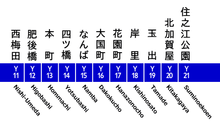Yotsubashi Line
 From Wikipedia the free encyclopedia
From Wikipedia the free encyclopedia
| Osaka Metro Yotsubashi Line | |||
|---|---|---|---|
 | |||
 A refurbished Yotsubashi Line 23 series EMU in August 2012 | |||
| Overview | |||
| Status | Operational | ||
| Owner | Osaka Metro (2018–present) Osaka Municipal Transportation Bureau (1942–2018) | ||
| Line number | 3 | ||
| Locale | Osaka, Japan | ||
| Termini | |||
| Stations | 11 | ||
| Color on map | Ocean blue (#0078BE) | ||
| Service | |||
| Type | Rapid transit | ||
| System | |||
| Depot(s) | Midorigi, Morinomiya (located on Chuo Line) | ||
| Rolling stock | 23 series EMUs | ||
| History | |||
| Opened | 10 May 1942 | ||
| Last extension | 9 November 1972 | ||
| Technical | |||
| Line length | 11.4 km (7.1 mi) | ||
| Track length | 11.8 km (7.3 mi) | ||
| Number of tracks | Double-track | ||
| Track gauge | 1,435 mm (4 ft 8+1⁄2 in) standard gauge | ||
| Electrification | 750 V DC (third rail) | ||
| Operating speed | 70 km/h (43 mph) | ||
| Signalling | Automatic closed block | ||
| Train protection system | WS-ATC | ||
| |||
Yotsubashi Line | |||||||||||||||||||||||||||||||||||||||||||||||||||||||||||||||||||||||||||||||||||||||||||||||||||||||||||||||||||||||||||||||||||||||||||||||||||||||||||||||||||||||||||||||||||||||||||||||||||||||||||||||||||||||||||||||||||||||||||||||||||||||||||||||||||||||||||||||||
|---|---|---|---|---|---|---|---|---|---|---|---|---|---|---|---|---|---|---|---|---|---|---|---|---|---|---|---|---|---|---|---|---|---|---|---|---|---|---|---|---|---|---|---|---|---|---|---|---|---|---|---|---|---|---|---|---|---|---|---|---|---|---|---|---|---|---|---|---|---|---|---|---|---|---|---|---|---|---|---|---|---|---|---|---|---|---|---|---|---|---|---|---|---|---|---|---|---|---|---|---|---|---|---|---|---|---|---|---|---|---|---|---|---|---|---|---|---|---|---|---|---|---|---|---|---|---|---|---|---|---|---|---|---|---|---|---|---|---|---|---|---|---|---|---|---|---|---|---|---|---|---|---|---|---|---|---|---|---|---|---|---|---|---|---|---|---|---|---|---|---|---|---|---|---|---|---|---|---|---|---|---|---|---|---|---|---|---|---|---|---|---|---|---|---|---|---|---|---|---|---|---|---|---|---|---|---|---|---|---|---|---|---|---|---|---|---|---|---|---|---|---|---|---|---|---|---|---|---|---|---|---|---|---|---|---|---|---|---|---|---|---|---|---|---|---|---|---|---|---|---|---|---|---|---|---|---|---|---|---|---|---|---|---|---|---|---|---|---|---|---|---|---|---|
| |||||||||||||||||||||||||||||||||||||||||||||||||||||||||||||||||||||||||||||||||||||||||||||||||||||||||||||||||||||||||||||||||||||||||||||||||||||||||||||||||||||||||||||||||||||||||||||||||||||||||||||||||||||||||||||||||||||||||||||||||||||||||||||||||||||||||||||||||
The Osaka Metro Yotsubashi Line (四つ橋線, Yotsubashi-sen) is an underground rapid transit line in Osaka, Japan, operated by Osaka Metro. The line connects Umeda, Hommachi, Yotsubashi, Namba, Daikokuchō and Suminoe, and runs parallel to the Midōsuji Line from Daikokuchō to Nishi-Umeda. Despite being the system's second line to open, its official name is Rapid Electric Tramway Line No. 3 (高速電気軌道第3号線), while the Osaka Municipal Transportation Bureau refers to it as Osaka City Rapid Railway Line No. 3 (大阪市高速鉄道第3号線), and in Ministry of Land, Infrastructure and Transport publications, it is written as Line No. 3 (Yotsubashi Line) (3号線(四つ橋線)). Station numbers are indicated by the letter Y.[1]
Overview[edit]
The Yotsubashi Line runs in a north and south direction. connecting the Osaka Metro Nankō Port Town Line at Suminoekōen Station. At first, it was a branch of the Osaka Metro Midōsuji Line, branching off at Daikokuchō Station but was extended north to Nishi-Umeda Station and made a separate line. This new section of the Yotsubashi Line takes a more direct routing to Nishi-Umeda running only 300–400 m (0.19–0.25 mi) west of the Midosuji Line.
History[edit]
- 10 May 1942 – Daikokuchō – Hanazonochō (opening)
- Construction stopped during World War II.
- 1 June 1956 – Hanazonochō – Kishinosato (opening)
- 31 May 1958 – Kishinosato – Tamade (opening)
- 1 October 1965 – Daikokuchō – Nishi-Umeda (opening)
- 9 November 1972 – Tamade – Suminoekōen (opening)
Future plans[edit]
A northward extension to Jūsō Station has been proposed since 1989.[2]
Operations[edit]
Most trains are operated between Nishi-Umeda station and Suminoe-Koen Station, with 2–3 minute interval during the morning rush hour, 6–7½ minute interval during the day, 3–4 minute intervals at the afternoon, 5–10 minute interval at night, and 10 minute interval in the early morning and late night. During the morning and evening (afternoon on weekends only), there are train that only run between Kita-Kagaya station and Nishi Umeda Station, as Kita-Kagaya is connected to the Yotsubashi Line depot at Midorigi.
In addition, on the day of the Suminoe boat race at night (excluding Sundays), one special train operates between 9pm and 10pm.
It is connected with the New-Tram at Suminoe-Koen station.
On 23 March 2013, the Osaka Bureau of Transport revised the timetable for the Yotsubashi Line. By using the train that was a going to a depot without any passengers, the final train became 0:20am for the northbound and 0:10am (for Suminoe-Koen) and 0:36am (for Kita-Kagaya) for the southbound. And because of passenger demand, for weekdays between 10am and 12pm was changed from 5 minute to 6 minute interval and for weekends and on holidays between 10am and 3pm was changed from 5-6 minute interval to 7-7½ minute interval.
Since 2016, the regular inspection of the trains used on the third rail lines of Osaka Metro has been carried at Midorigi depot, trains of the Midosuji Line, the Tanimachi Line, the Chuo Line, and the Sennichimae Line may run on the Yotsubashi Line.
Stations[edit]
All stations are in Osaka.
Rolling stock[edit]
Current[edit]
- 23 series (since 1990)
All trains are based at Midorigi Depot. Since 2014, Yotsubashi Line trains are also able to access Morinomiya Depot located on the Chuo Line, after a connecting track was built between these two lines near Hommachi Station. Currently all trains are 6 cars long but subway platforms are long enough to accommodate trains up to 8 cars long.
Former[edit]
- 400 series (1942–1969)
- 1000 series (1956–1971)
- 1100 series (1958–1979)
- 1200 series (1958–1980)
- 50 series (1960–1980)
- 30 series (1972–1996)
See also[edit]
References[edit]
- ^ 四つ橋線. Osaka Kotsu (in Japanese). Osaka Municipal Transportation Bureau. Retrieved 5 August 2014.
- ^ 北ヤード新線、大筋合意 大阪市地下鉄四つ橋線乗り入れ. Asahi Shimbun (in Japanese). 9 December 2006. Retrieved 5 August 2014.
